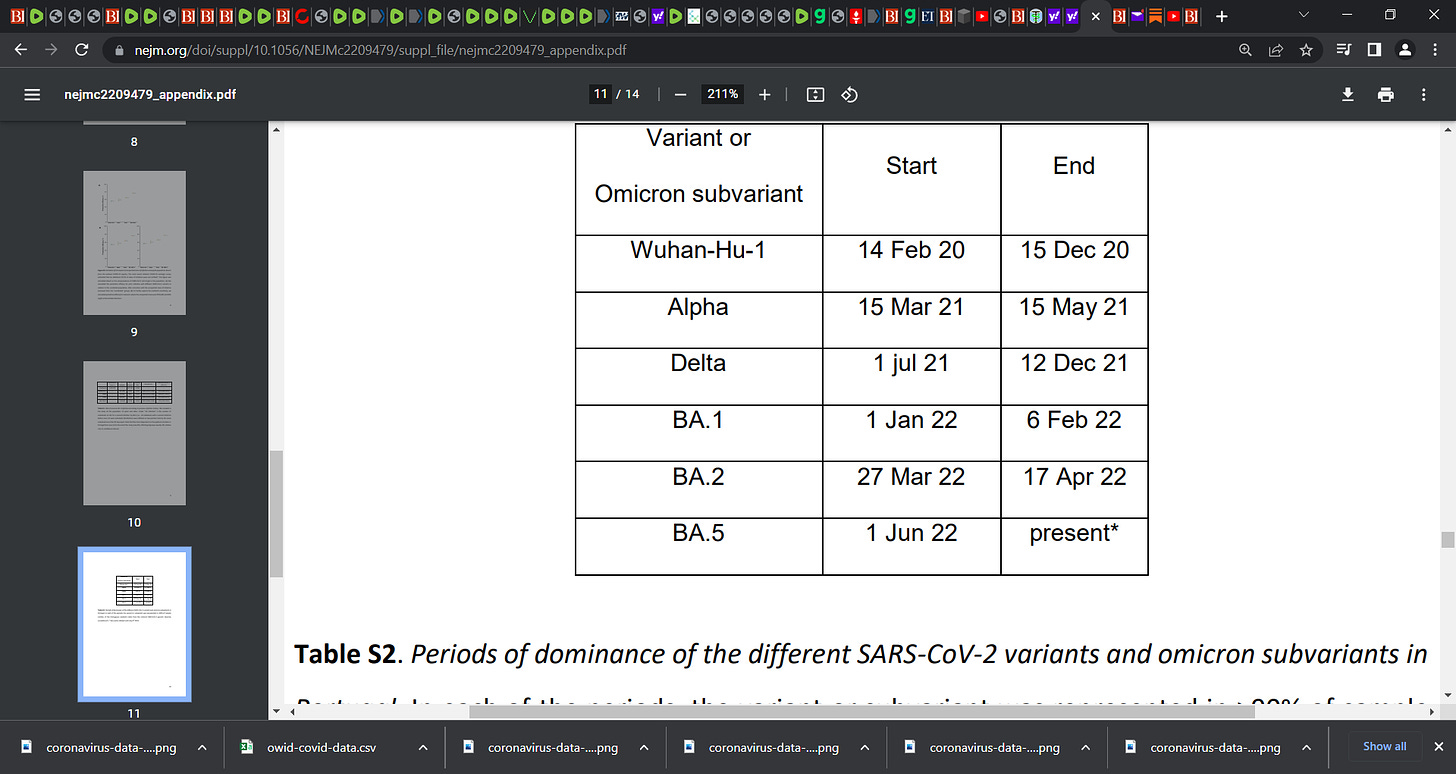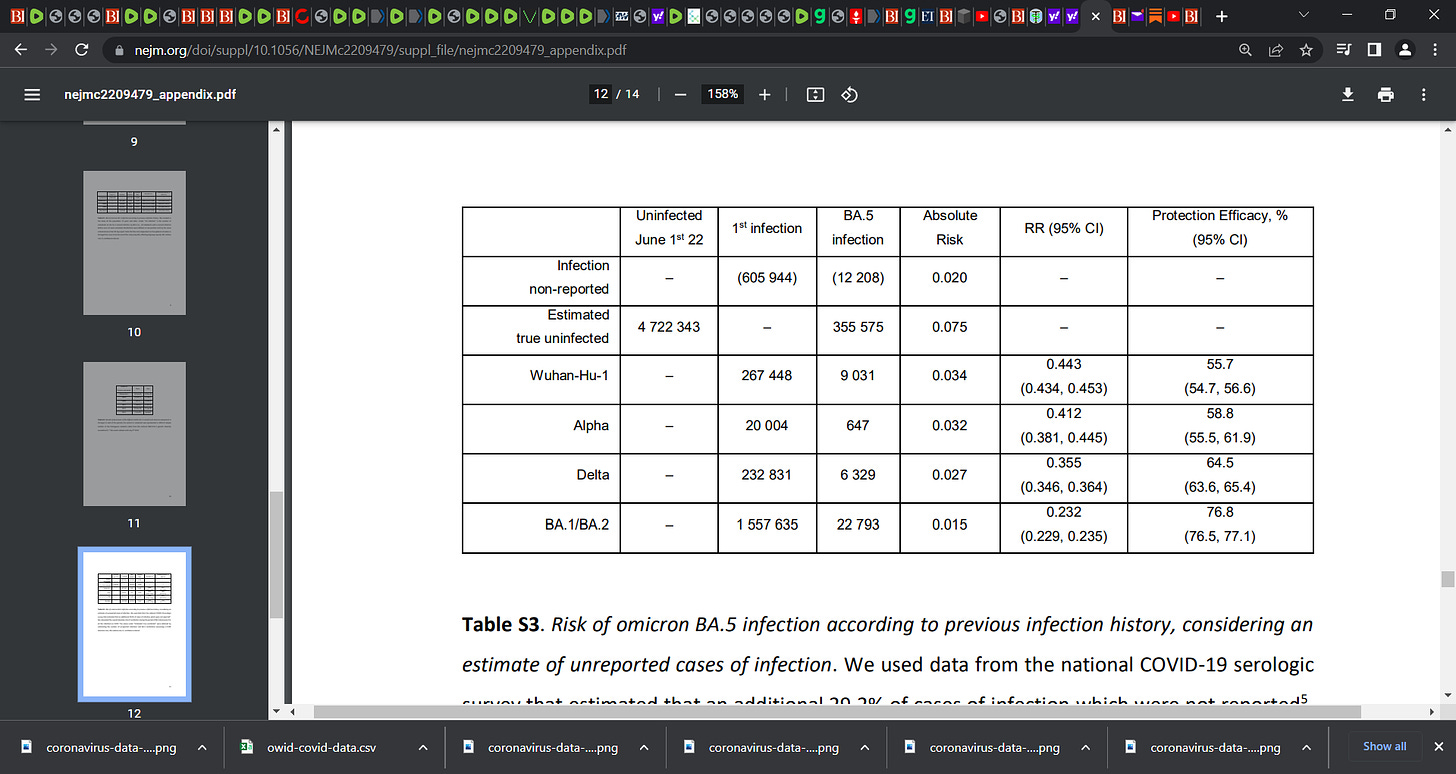NATURAL immunity WINS again in Portugal: Graca & Malato et al., NEJM, "Risk of BA.5 Infection among Persons Exposed to Previous SARS-CoV-2 Variants"; Overall, we found that breakthrough infections...
by Paul Alexander
with BA.5 subvariant were less likely among persons with previous SARS-CoV-2 infection history in a highly vaccinated population, especially for prior BA.1 or BA.2 infection, than among the uninfected
What this study is showing us again is that natural exposure immunity is far more robust, potent, long-lasting, complete than any vaccine immunity. We had evidence even from a study that showed persons alive who were 95 years old, so near a century after Spanish Flu, in 2008 or 2010 (about) had an immune response still to the Spanish Flu they were exposed to as little kids.
Do not forget my paper on natural immunity used today by courts and the US house and senate (I cannot share beyond that):
The key finding in the study we are looking at here (in 9.3 million Portuguese people, so a robust data set) of less breakthrough (limited) infection with the current dominant BA.5 sub-variant clade is great news for natural immunity for it shows it is holding. This if one was prior infected with BA.1 and BA.2 clades. I have to read further and look at the supplementary but wanted to share this nice finding. What I find very good is that the prior sub-variants and strains still give some protection against BA.5 clade.
Firstly, let me address the methods here:
These researchers applied a registry-based study design that indeed lacks the level of precision of a test-negative design. Yet as they rightly argue, the very large number of cases studied that covered all the residents of Portugal over 12 years old, allowed confidence in a derived risk estimate for individuals with prior BA.1/BA.2 infection that was robust and trustworthy enough and located close to an estimate from Qatar based on a test-negative design. I felt the argument was reasonable and felt that the design was acceptable and the methods robust, though not the most rigorous design. Note they looked at the N nucleocapsid protein (the core of the virus that protects the genome) and not the spike protein. The N nucleocapsid protein involves natural exposure, infection and immunity.
Are you surprised by this robust natural immunity finding in Portugal? I am not!
Background and findings:
“Portugal was one of the first countries affected by a BA.5 predominance. We used the national coronavirus disease 2019 (Covid-19) registry (SINAVE) to calculate the risk of BA.5 infection among persons with documented infection with past variants, including BA.1 and BA.2. The registry includes all reported cases in the country, regardless of clinical presentation.”
“We found that previous SARS-CoV-2 infection had a protective effect against BA.5 infection, and this protection was maximal for previous infection with BA.1 or BA.2. These data should be considered in the context of breakthrough infections in a highly vaccinated population, given that in Portugal more than 98% of the study population completed the primary vaccination series before 2022.”
Conclusion:
“Overall, we found that breakthrough infections with the BA.5 subvariant were less likely among persons with a previous SARS-CoV-2 infection history in a highly vaccinated population, especially for previous BA.1 or BA.2 infection, than among uninfected persons.”
SOURCE:
Natural immunity WINS again!: Risk of BA.5 Infection among Persons Exposed to Previous SARS-CoV-2 Variants, Graca, 2022
Figure 1. Protective Effect of Previous SARS-CoV-2 Infection on Infection with the Omicron BA.5 Subvariant.
https://www.nejm.org/doi/suppl/10.1056/NEJMc2209479/suppl_file/nejmc2209479_appendix.pdf
As shown in Panel A of the above graph (above the table S1., we identified the periods (in different colors) when one variant was represented in more than 90% of sample isolates (data from the national severe acute respiratory syndrome coronavirus 2 [SARS-CoV-2] genetic diversity surveillance4). The periods in gray represent times when more than one variant was in circulation. Given the relatively slow transition between dominance by the omicron BA.1 subvariant and dominance by the omicron BA.2 subvariant, we pooled BA.1 and BA.2 in the analysis. We did not include anyone infected in the 90 days before dominance by the omicron BA.5 subvariant. Panel B shows protection efficacy against infection during the period of BA.5 dominance (from June 1, 2022) among persons with one infection in the periods of dominance of different variants, as represented in Panel A, as compared with persons without any documented infection until June 1. Persons with two infections before June 1 were not included in the study. 𝙸 bars represent 95% confidence intervals.




